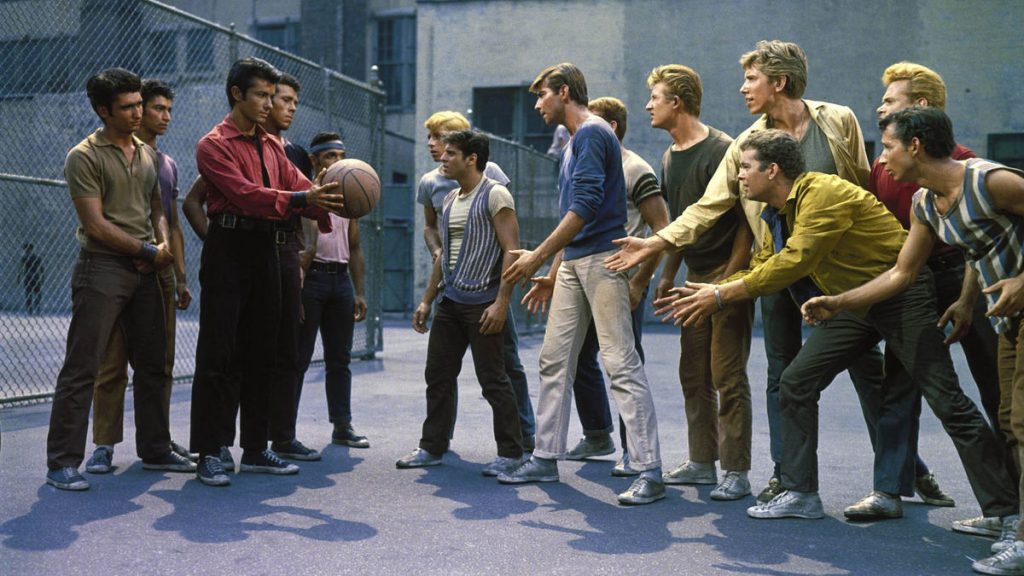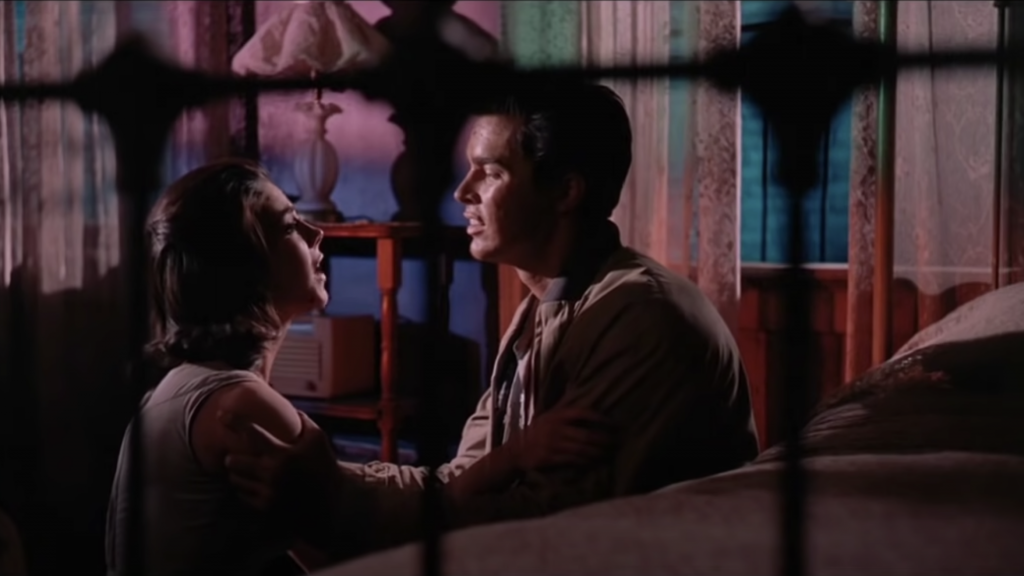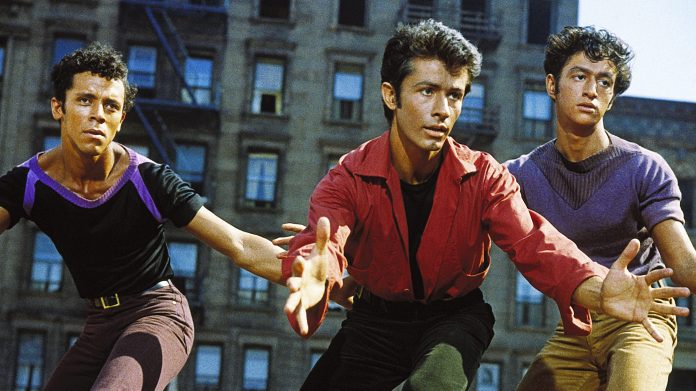The renowned classic West Side Story celebrates its sixtieth anniversary today, and it stands up all these years later as a textbook example on how to bring a stage musical to life on the screen.
It is no easy feat, as some recent high profile misfires prove. Just look at 28-year-old Ben Platt’s ‘teenage’ face in the recent Dear Evan Hansen, or Andrew Lloyd Webber’s traumatised response to Cats. In light of these recent missteps, perhaps it’s best to cast one’s eye upon one of the most critically acclaimed musical films of all time. In particular, just how did it use the camera to tell this classic story in a way that the stage simply can’t?
By the time it debuted on Broadway in 1957, West Side Story redefined musical theatre in its entirety. The book, written by Arthur Laurents, revolved around a remake of Shakespeare’s Romeo and Juliet, set amidst a turf war between white and Puerto Rican gangs in the Upper West Side of New York (at the time a diverse, blue-collar neighbourhood). The music, composed by Leonard Bernstein, bridged the gap between contemporary Latin and classical modernist influences. The extended dance sequences, choreographed by Jerome Robbins, were so impressive that critic Walter Kerr wrote that he “put together, and then blasted apart, the most savage, restless, electrifying dance patterns we’ve been exposed to in a dozen seasons.”
It is obvious that the film has almost impossibly high standards to live up to. Luckily, it was directed by Robbins and Robert Wise, a well-established director then known for his noir films such as Born To Kill (1947) and Odds Against Tomorrow (1959). Robbins however was fired midway through filming, calling for numerous retakes, thus going way behind schedule and way over budget. Looking at the key scenes in the film, it’s easy to see how both directors contributed to the success of the film.
The film’s overture and prologue is essential to establishing West Side Story’s tonal play between the surreal and the real, the dreamlike and the destructive. The film opens with an overture, which could have easily been tossed away. In fact, it’s essential to introduce key motifs and ideas in the musical, like a wordless synopsis with no spoilers. The simple, abstract landscape of the New York skyline foregrounds the bold, theatrical style of the film. It’s a clear message; this is not like any other musical film you’ve seen before.

The following prologue expands on this idea of place with its almost documentarian approach to New York City. Wise was meticulous in scouting shooting locations, and the film now stands as an eerie tribute to an area which has since been completely bulldozed over. The stage can’t quite capture the same immense space of New York as established by the soaring aerial shot. It’s from this angle that you can see wide, main roads, and tiny alleyways where all sorts of trouble could happen.
It’s not until an additional scene until we really understand the violent playground the Sharks and the Jets find themselves in. The Jets, having exited the basketball court and entered Shark territory, run along the street, the dolly mirroring their fluid movements and elongating the road. Suddenly, the Sharks have the upper hand. People throw stones at the Jets, spook them, and dump paint on them. This opening conflict roots the film even more firmly in the social dynamics of New York and amplifies the reality of the Sharks and the Jets. It doesn’t matter if the Sharks outnumber the Jets; structural racism ensures that they will always be the loser (signified by the arrival of Lieutenant Schrank and Officer Krupke).
In the theatre, most audience members are so far away that facial expressions have to be exaggerated in order to be registered. In film, viewers have the luxury of being more intimate with the actors courtesy of close ups and zooms. In West Side Story, the relationship between Tony and Maria is filmed less like a live recording and more like a music video, where aesthetics reigns supreme over logical or temporal continuity.
Wise indulges in this advantage by heightening the surreal circumstances of Tony and Maria’s love story in the cinematography. Think of the first time Tony and Maria meet at the school dance. In the midst of the competition, the dancers suddenly blur, until Maria is singled out in perfect focus in the shape of an oval. So, too, is Tony, and the two teenagers drift together closer and closer in their bubbles until it fades into a dream sequence. It’s like a highly stylised rack shot, intensified tenfold, and Wise executes its placement within the narrative perfectly.

Other scenes feature clever colour and prop usage to communicate the love Tony and Maria feel in spite of the obstacles that face them. “There’s a place for us,” Tony famously croons to Maria, as they embrace in the ballad ‘Somewhere.’ Behind them, out of sight, are the opposing red and blue colours of the Sharks and Jets projected through the window. Once Maria begins her verse, their two heads are positioned in the centre of these two factions, representing the barriers between them. As they continue to sing to each other, the camera moves outside the bed frame, like domestic prison bars. For a brief moment, the teenagers ascend, dreaming of ‘somewhere’ – but the red and blue manages to haunt them to their right. Once they fall out of shot, all that’s left are the colours that will come to define their demise.
West Side Story has lived a complicated afterlife since the film was released. On the one hand, it revitalised what kinds of stories musical theatre could tell, immortalising the original production’s legacy doing so with striking attention and care. Its ten academy awards point to a film almost assured of cultural staying power. Conversely, West Side Story came to monopolise representations of Puerto Ricans. Offensive or generalising stereotypes of Puerto Rican appearance is now being corrected by the Steven Spielberg remake, due for release this December. It’s also being executive produced by Rita Moreno, who won the Oscar for Best Supporting Actress as Anita in the 1961 film.
West Side Story has come to occupy an important space in the tradition of the musical film, refusing to become a lazy shot-for-shot rendition of the stage. Instead, the film is ambitious in its vision, asking us what film can do to liberate the musical from the constrictions of the stage.
Words by Alex Rigotti
Support The Indiependent
We’re trying to raise £200 a month to help cover our operational costs. This includes our ‘Writer of the Month’ awards, where we recognise the amazing work produced by our contributor team. If you’ve enjoyed reading our site, we’d really appreciate it if you could donate to The Indiependent. Whether you can give £1 or £10, you’d be making a huge difference to our small team.
